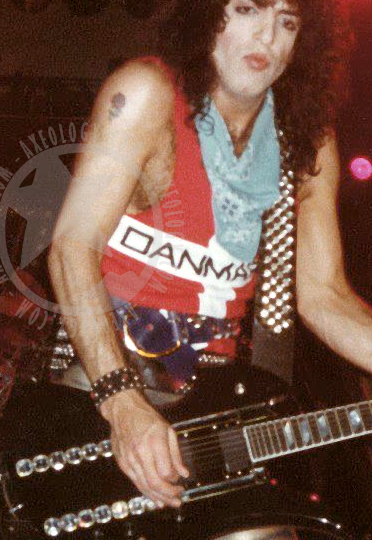
As should have become apparent by now, nothing is ever easy when it comes to Paul and his vast array of guitars and in Houston, TX on March 10 there appears a second B.C. Rich Eagle. This one has the same specifications as the first Eagle except that it came with Schaller M6 tuners and that the paint job, although similar, is of an animal I have not had the pleasure of laying eyes on. The color scheme is the same on both but #1 has a more natural "spotted" leopard print while #2 has a "streaky" kind of pattern (as seen in this comparison). The March 10 appearance is the first dated one I know of but it's perfectly possible that is was along for the ride as a backup before then.
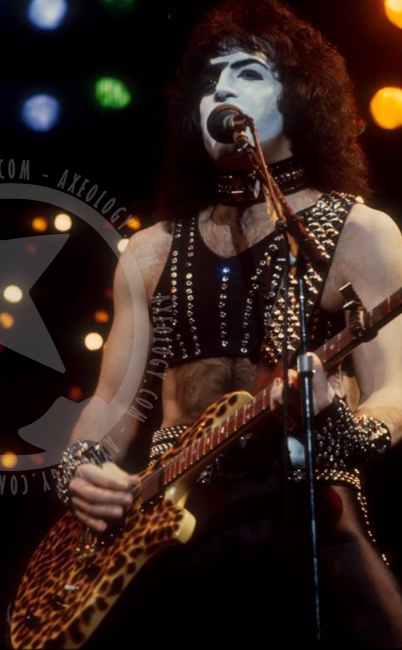
In 1982, some time between the failed attempt of credibility that was The Elder and the beginning of promo work for Creatures of the night, Paul got a few new guitars. Suddenly B.C. Rich had entered the fold and the obvious question is: why? The answer is probably as simple as recommendation. Bob Kulick had played on all of the new tracks on the recent release Killers and at the time he was a fan of B.C. Rich guitars. In the 1982 B.C. Rich catalogue he is listed among the "friends" of B.C. Rich meaning the people who played their guitars. Bob was personally fond of the Bich model, using a 6-string koa version on stage with Meat Loaf in 1978 (see the performances at Rockpalast and The Old Grey Whistle Test and be on the lookout for Bruce) and later sporting a hideous light purple Bich while backing Diana Ross on the Tonight Show in 1981. Whatever else can be said about Bob it is clear that Paul respected him as a musician considering their long history and it's not far-fetched to believe that he also respected his opinion on guitars.
Although originally working out of Bernardo's Guitar Shop which was owned by his father, Bernardo Chavez Rico started experimenting in building guitars along with partners Bob Hall and Mal Stich in the early 70's. Under the name B.C. Rich their Seagull model hit the market as a production model in 1974. It's important to understand that B.C. Rich wasn't really a custom shop, all their guitars were based on a standard selection of models that could be had in various versions. What they were, were hand made. Bodies, necks, fretboards and electronics were all made on site while most of the hardware was, at least initially, from other manufacturers. The tuners were Grover Rotomatic Imperials, pickups were usually DiMarzios, and the bridges were Leo Quan Badass. With the introduction of the 10-string Bich in 1977 the Quadmatic bridge was introduced, mainly out of necessity.
Apart from crafting high-end hand made instruments a big selling point to the B.C. Rich were their electronics. Almost ridiculously elaborate they allowed the user to control almost every facet of the sound.
Although originally working out of Bernardo's Guitar Shop which was owned by his father, Bernardo Chavez Rico started experimenting in building guitars along with partners Bob Hall and Mal Stich in the early 70's. Under the name B.C. Rich their Seagull model hit the market as a production model in 1974. It's important to understand that B.C. Rich wasn't really a custom shop, all their guitars were based on a standard selection of models that could be had in various versions. What they were, were hand made. Bodies, necks, fretboards and electronics were all made on site while most of the hardware was, at least initially, from other manufacturers. The tuners were Grover Rotomatic Imperials, pickups were usually DiMarzios, and the bridges were Leo Quan Badass. With the introduction of the 10-string Bich in 1977 the Quadmatic bridge was introduced, mainly out of necessity.
Apart from crafting high-end hand made instruments a big selling point to the B.C. Rich were their electronics. Almost ridiculously elaborate they allowed the user to control almost every facet of the sound.
Now, Paul may have been impressed with the build quality and the playability of the B.C. Rich guitars but there were two things he did not like about them. "I remember sitting down with those guys and going, 'What the hell is this crap?! Your guitar looks like a coffee table and it's got too many switches!' A good guitar needs a volume and a tone and if you can't get what you're looking for out of that, you need a new guitar." (Vintage Guitar 1997) Needless to say, Paul got his will.
Thanks to Norwegian fan Petter Vestengen Nessjøen who wrote to B.C. Rich in 1984 we have some hard facts about these guitars. Paul's Eagles were made of maple and had standard features like the Grover Rotomatic Imperial tuners, the all-brass Quadmatic bridge, and the brass truss rod cover. Also a standard feature, and a first for Paul, the Eagle had 24 frets. The pickups, however, appear to be EMG 81's (although B.C. Rich claim that there was a DiMarzio Super II in the bridge position) and the electronics have been greatly simplified looking more like the relatively simple layout of the import (and lower-priced) NJ series which was introduced in 1983. Keeping with the "creature" theme of his guitars for the 10th Anniversary Tour the Eagle looks nothing like a coffee table and a whole lot like a leopard.
The B.C. Rich Eagle is the guitar during the brief run of promotional playback "performances" in Europe during November and December. The photo on the left from Rome, Italy shows Paul "playing" the unison bends in I love it loud, a job he had to undertake since Ace obviously wasn't even aware what song they were playing and couldn't even fake the rhythm parts.
Thanks to Norwegian fan Petter Vestengen Nessjøen who wrote to B.C. Rich in 1984 we have some hard facts about these guitars. Paul's Eagles were made of maple and had standard features like the Grover Rotomatic Imperial tuners, the all-brass Quadmatic bridge, and the brass truss rod cover. Also a standard feature, and a first for Paul, the Eagle had 24 frets. The pickups, however, appear to be EMG 81's (although B.C. Rich claim that there was a DiMarzio Super II in the bridge position) and the electronics have been greatly simplified looking more like the relatively simple layout of the import (and lower-priced) NJ series which was introduced in 1983. Keeping with the "creature" theme of his guitars for the 10th Anniversary Tour the Eagle looks nothing like a coffee table and a whole lot like a leopard.
The B.C. Rich Eagle is the guitar during the brief run of promotional playback "performances" in Europe during November and December. The photo on the left from Rome, Italy shows Paul "playing" the unison bends in I love it loud, a job he had to undertake since Ace obviously wasn't even aware what song they were playing and couldn't even fake the rhythm parts.

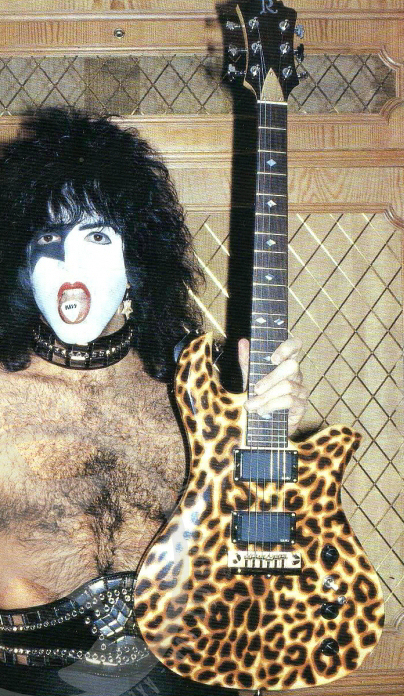


The 10th Anniversary Tour tour book also introduced Paul's second B.C. Rich: a black Mockingbird with gemstone "trim" running the length of the body. (These gemstones, apparently "multifaceted Swedish crystal", actually line up very well with the "stripes" that flanked the neck-through on the Mockingbirds.) Paul's Mockingbird had "a maple base" which differs from the mahogany that had been his wood of choice for a number of years. Much like the Eagle, the Mockingbird features EMG pickups, Grover Rotomatic Imperial tuners, and simplified electronics. Unlike the Eagle, and quite unlike the standard Mockingbird, Paul's version had binding on the neck and headstock, parallelogram pearl inlays on the fretboard, and a Schaller 455 bridge.
The photo by Bernard Vidal on the right (as seen in the tour book) does seem to show humbuckers with pole pieces but since the pic isn't good enough to say for sure and the version of the Mockingbird that went on the road had EMG's I'll just say that there were active pickups from the start and leave it at that.
The photo by Bernard Vidal on the right (as seen in the tour book) does seem to show humbuckers with pole pieces but since the pic isn't good enough to say for sure and the version of the Mockingbird that went on the road had EMG's I'll just say that there were active pickups from the start and leave it at that.
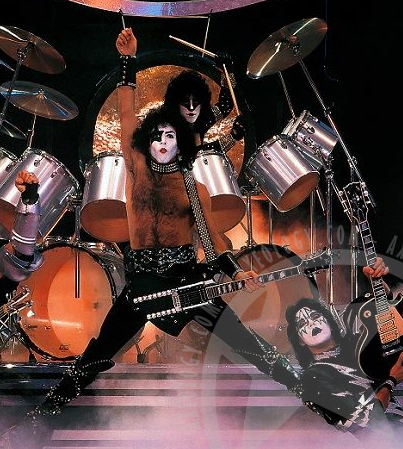
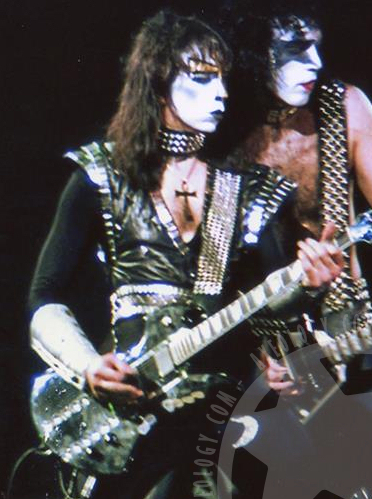

Staying briefly with the Mockingbird it seems to have been used mainly as a backup during the tour and the photos showing it are relatively scarce. It first shows up in Vinnie's hands in Toledo, OH on January 8. Now, there are quite a few shots of Paul playing the guitar but precious few (that I know of) are properly dated. We know that Vinnie played it quite a bit in the early stages of the tour - he's seen with it in Toronto, Canada on January 14 and again in Syracuse, NY on January 18 - but the only dated appearance of the Mockingbird in Paul's hands isn't until Biloxi, MI on March 18. All things considered he has to have played it before then despite traveling with six guitars.
One thing to mention about the Mockingbird is that it is completely unchanged throughout this (and the next) tour. Even the Imperial tuners stayed on despite Paul's apparent love for the Schaller M6.
One thing to mention about the Mockingbird is that it is completely unchanged throughout this (and the next) tour. Even the Imperial tuners stayed on despite Paul's apparent love for the Schaller M6.
The Eagle had the enviable task of opening the show for the better part of the tour. Although the #2 Hamer Standard does show up wearing a capo for a show or two, the Eagle was first choice for the opening number as can be seen in the photo on the right and in Toledo, OH on January 8. Should video be your preferred poison the footage from the show in Montreal, Canada on January 13 will show the same thing.
That said, the Eagle did handle some additional duties without a capo. As this photo from Toronto, Canada on January 14 shows, Paul uses it here and there without a capo. It even logged some time during the latter part of the show, seen here during the "tank finale" in Black Diamond in Norfolk, VA on January 25. Paul also soon decided that the Grover Rotomatic Imperial tuning pegs weren't to his liking and they were replaced by Schaller M6's. Earlier photos from the tour are inconclusive as to whether the change occured sooner. The Imperials were definitely still on the guitar during the European promo tour late 1982 and the switch could have happened before the tour began.
That said, the Eagle did handle some additional duties without a capo. As this photo from Toronto, Canada on January 14 shows, Paul uses it here and there without a capo. It even logged some time during the latter part of the show, seen here during the "tank finale" in Black Diamond in Norfolk, VA on January 25. Paul also soon decided that the Grover Rotomatic Imperial tuning pegs weren't to his liking and they were replaced by Schaller M6's. Earlier photos from the tour are inconclusive as to whether the change occured sooner. The Imperials were definitely still on the guitar during the European promo tour late 1982 and the switch could have happened before the tour began.


Thankfully the unmasking didn't do much to alter Paul's basic guitars. Eagle #2 seems to get a little more stage time during the American leg, even being brought out for his "solo" spot before Gimme more on occasion, but it is still the backup along with the Mockingbird. As for Eagle #1, it shares the main duties with the Hamer Vector and just keeps doing its job. As far as I can tell there are no changes to either Eagle over the course of the Lick it up Tour.
The Lick it up Tour also saw the start of an endorsement deal between Paul and B.C. Rich, his first since the split from Ibanez. In the tour books for both the European and American leg of the tour this ad appears and in the 1984 Japanese B.C. Rich catalog both Paul and Bruce is listed among the artists playing B.C. Rich.
The Lick it up Tour also saw the start of an endorsement deal between Paul and B.C. Rich, his first since the split from Ibanez. In the tour books for both the European and American leg of the tour this ad appears and in the 1984 Japanese B.C. Rich catalog both Paul and Bruce is listed among the artists playing B.C. Rich.



Since Paul was pictured with the Mockingbird in his first ad it was only fitting that it also made the trip to Europe. It doesn't seem to get much use at first, the Hamers and the Eagles are the favorites, but in Malmö, Sweden on November 20 and in Denmark as seen on the left it features prominently. (For photos from Malmö consult p. 110-111 of KISS i Sverige.) The Mockingbird is still completely original, even retaining the Rotomatic Imperial tuners that Paul quickly removed from his #1 Eagle.
Also present for the European Tour was a B.C. Rich Warlock II. This guitar is so elusive, so far represented only by the photo below courtsey of KISS Army Spain, that I originally thought the photo was a fake. However, the guitar is mentioned in the letter from B.C. Rich to Petter Vestengen Nessjøen so I stand corrected. The Warlock II was made of mahogany and was a neck-through construction like the other B.C. Riches but this had a reverse "curved" headstock. According to the letter it had a Schaller bridge and I assume it's the same model as the Mockingbird (455).
One thing that the B.C. Rich letter mentions that I think is incorrect is the pickup configuration on these guitars. The letter only mention the pickups of two eagles and the Warlock II explicitly but the specs for those are all the same: "an EMG p.u. is used in the lead position and a Dimarzio [sic.] Super II is used in the rhythm position". Now, I've spent more time than I care to admit looking at photos of the two Eagles and the Mockingbird and I have never once seen any of them outfitted with a DiMarzio Super II. (Eagle #1 eventually gets a new pickup but that's in 1992, 8 years after this letter was written.) Every single photo I've seen suggest that from 1983-1986 all of Paul's B.C. Rich guitars were equipped with EMG pickups in both positions. (The DiMarzio Super II, or Super 2, was available in two versions. Both had very obvious pole pieces.)
One thing that the B.C. Rich letter mentions that I think is incorrect is the pickup configuration on these guitars. The letter only mention the pickups of two eagles and the Warlock II explicitly but the specs for those are all the same: "an EMG p.u. is used in the lead position and a Dimarzio [sic.] Super II is used in the rhythm position". Now, I've spent more time than I care to admit looking at photos of the two Eagles and the Mockingbird and I have never once seen any of them outfitted with a DiMarzio Super II. (Eagle #1 eventually gets a new pickup but that's in 1992, 8 years after this letter was written.) Every single photo I've seen suggest that from 1983-1986 all of Paul's B.C. Rich guitars were equipped with EMG pickups in both positions. (The DiMarzio Super II, or Super 2, was available in two versions. Both had very obvious pole pieces.)
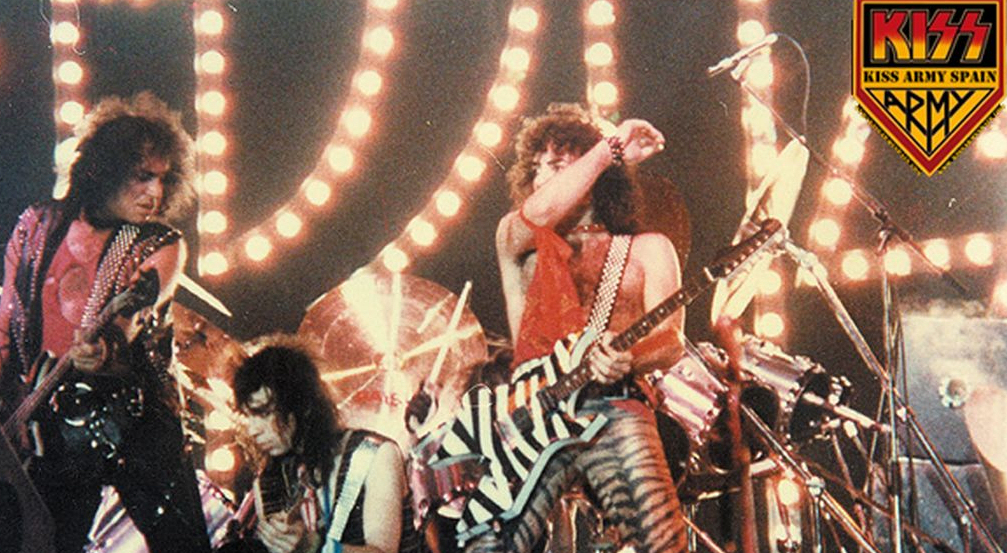
Before moving on we need to adress strap security. Whereas Gene found his prefered method in 1976, moving from the screw/washer to a screw-in loop and carbiner combo and pretty much sticking to that until the present day, Paul tried a few things along the way. For instance, in 1977 he used the screw/washer for the Gibson Explorer while he had a screw-in loop and carbiner for the Gibson Doubleneck. When using his PS10's in 1977-79 he seemed to just use the standard strap button even if it was placed in a non-standard spot on the back of the guitar, while the Gibson Explorer II had a large and noticable screw/washer. And then the real fun begins...
I must confess that I'm not at all sure how the Hamer Standards were outfitted during the Return of KISS Tour. The photo on the right from Los Angeles, CA show one of them and the rest of the photos from that show and others at the time suggest that it's probably #2. The neck strap button looks pretty standard (pun intended) although this might be the first use of a solution that Paul would later adopt on all his guitars. Interesting fact about the #2 Hamer Standard is that it had the same location of the lower strap button as the PS10's: on the back of the body. I for one struggle to find any evidence of a strap button on the bottom of the #2 in 1979 or 1980.


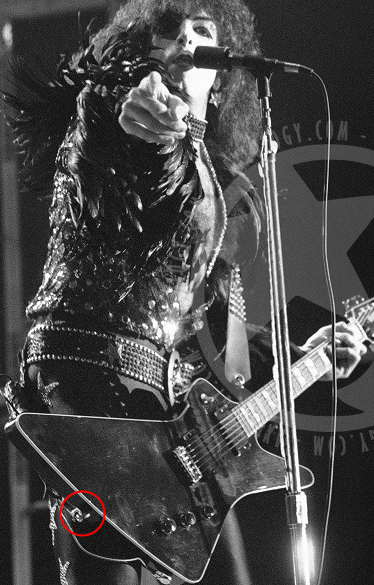
By contrast the #1 Hamer Standard (as seen on the left) had a screw-in loop and carbiner during the Unmasked Tour. This feature was retained for the performance on Friday's in 1982 and it was also the prefered choice for the Hamer Vector in its original white guise. Then, with the coming of the B.C. Riches in 1982-83, things change.
Strap buttons on B.C. Rich guitars were nothing special. The neck strap button was usually placed on the back of the body regardless of model but, although they were sometimes fairly substantial, they were just regular strap buttons. The ones on Paul's B.C. Riches, and his remaining Hamers, were not.
Strap buttons on B.C. Rich guitars were nothing special. The neck strap button was usually placed on the back of the body regardless of model but, although they were sometimes fairly substantial, they were just regular strap buttons. The ones on Paul's B.C. Riches, and his remaining Hamers, were not.

When we first meet the new B.C. Riches in the shape of the #1 Eagle during the European promotion tour it sports a massive strap button that's hard to miss. This is a Dunlop Straplok and starting in 1983 Paul used them almost exclusively. Like all minor details they are hard to spot, especially when Paul moved to black straps and black strap buttons, but they're there. The Zebra Vector got a set, the Mockingbird had them, and naturally both Eagles had them as well. (The one exception that I know of is that the Flag B.C. Rich Gunslinger appeared to use a black Schaller Security Lock in 1990.)
The Dunlop Straplock is a fairly elaborate system that, like most straplocking solutions, has a replacement strap button and a separate part that attaches to the strap itself. In this case the locking against the strap is with a retainer clip that secures the locking pin to the strap via two washers. The locking pin uses spring-loaded ball bearings to lock onto the strap button. Since any two Straploks are interchangeable this allows for one strap with attached wireless system to be used for any guitar which might have been preferable compared to the "mix and match" solutions used earlier. Videos and photos from 1983-85 suggest that Paul used mainly two straps on the road and although guitars were mostly handed off to roadies strap and all, which isn't surprising considering the fairly common practice of taping the output jack in place, these straps were then moved between different guitars as need be. The same guitar frequently appear in photos with different straps depending on where on the show it's used.
The Dunlop Straplock is a fairly elaborate system that, like most straplocking solutions, has a replacement strap button and a separate part that attaches to the strap itself. In this case the locking against the strap is with a retainer clip that secures the locking pin to the strap via two washers. The locking pin uses spring-loaded ball bearings to lock onto the strap button. Since any two Straploks are interchangeable this allows for one strap with attached wireless system to be used for any guitar which might have been preferable compared to the "mix and match" solutions used earlier. Videos and photos from 1983-85 suggest that Paul used mainly two straps on the road and although guitars were mostly handed off to roadies strap and all, which isn't surprising considering the fairly common practice of taping the output jack in place, these straps were then moved between different guitars as need be. The same guitar frequently appear in photos with different straps depending on where on the show it's used.

After the Lick It Up Tour ended in March of 1984 the Zebra Vector and the Tiger Standard (#2) were retired and, for the most part, the newer B.C. Riches ruled. Once the Animalize Tour starts in the fall Eagle #1 had become the uncontested #1, a postion it had quitely gained during the latter stages of the previous tour, and this additional use soon started to show. The most obvious indication was the gaffer's tape that appeared on the top part of the body at the armrest bevel. This was probably added due to damage to the finish, much like on Gene's black Pedulla, and followed the band's general guideline for repairs/modifications: if it's looks good five rows out, it's good enough. In this instance Paul's arm obscured the taped part most of the time and most people probably never noticed.
Also added at this time, and much harder to spot, was a huge piece of adhesive covering the control cavity on the back. In contrast, when the #1 Eagle "arrived" the control cavity cover looked normal as seen in the photo from 1982-12-01 above. Since I find it hard to believe that Paul's tech did enough work on the electronics to damage the screw heads or strip the wood my guess is that it was added just as a precaution, perhaps to safe-guard against sweat. Another minor thing that was probably present from the start (previous photo evidence is lacking) is some text and a small symbol on the back. It's not clear what it actually says but in some later photos it looks like it just says "B C Rich" which is one reason why I think it was probably there all along.
Also added at this time, and much harder to spot, was a huge piece of adhesive covering the control cavity on the back. In contrast, when the #1 Eagle "arrived" the control cavity cover looked normal as seen in the photo from 1982-12-01 above. Since I find it hard to believe that Paul's tech did enough work on the electronics to damage the screw heads or strip the wood my guess is that it was added just as a precaution, perhaps to safe-guard against sweat. Another minor thing that was probably present from the start (previous photo evidence is lacking) is some text and a small symbol on the back. It's not clear what it actually says but in some later photos it looks like it just says "B C Rich" which is one reason why I think it was probably there all along.
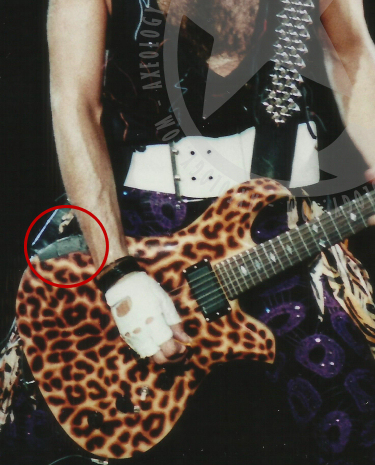

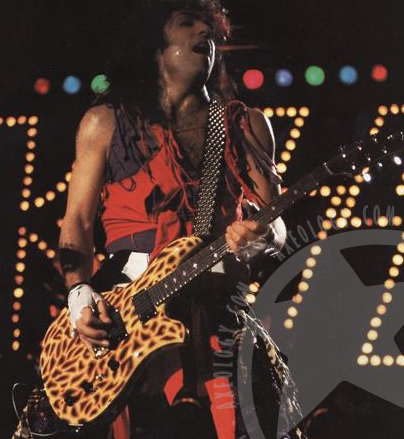
Eagle #2, thrust into the backup role, doesn't seem to have suffered any ill effects on the finish as did its more popular brother. During a few of the European shows, notably in Stockholm, it was called upon to carry a slightly heavier load than usual but for the most part it was probably used for Creatures of the night as it was during the American part of the tour. Although there are no photos of it from this time there are, in fact, photos from the American part of the tour (as seen in Charlotte, NC on January 6, 1985) that lead me to believe that Eagle #2 also had its control cavity taped when the Animalize Tour started. The work on the control cavity of Eagle #2 looks a lot shoddier than that on Eagle #1 above but I have a feeling that it was originally just as "clean". By January of 1985 the adhesive precaution of Eagle #1 was evidently in need of some repairs and in some photos one can see an additional piece of tape holding the original work in place.

The Mockingbird also saw its use increased toward the end of the Lick It Up Tour (photo on the left from New York, NY in March), and it was part of the arsenal when the band started the Animalize Tour. However, this time around it doesn't seem to have gotten much use at all. It featured prominently in the blue background photo shoot but I've seen just this one live photo from Glasgow, Scotland on October 5. I've looked through as many magazine scans as I have ben able find, my own collection of clippings, and the excellent books KISS i Sverige and Klassified, and it seems as if the Mockingbird is only captured on stage that one time. (The blue background photo shoot, incidentally, took place in Stockholm, Sweden on October 26 and it is probably the reason for the existance of this site. I fell head-over-heels in love with that guitar when I saw it in the pages of OKEJ magazine in 1985.)

For the US part of the Animalize Tour Paul got a new B.C. Rich, this one a cracked mirror Warlock as seen on the right. The Warlock was designed by Bernie Rico in 1981 but not properly introduced until 1982. According to Rico the Warlock "was the only guitar I ever designed at a drafting table, using straight-edges and French curves. [...] It was lots of curves going into straight lines. At first I thought it was the ugliest guitar I'd ever designed." (Vintage Guitar February 1995) The design drawing later caught the eye of local guitarist Spencer Sercombe which prompted the model to actually get made. It would become a favorite of a lot of hard rock and metal guitarists in the mid-80's, more or less help define the emerging genre and prove a massive commercial success. To name a few early users, Nikki Sixx of Mötley Crüe had several Warlocks as did Kerry King of Slayer and both Blackie Lawless and Randy Piper of WASP.
Paul's cracked mirror Warlock had the company's new curved six-in-line headstock, a chrome Quadmatic bridge, two EMG 81 pickups, and the simplified electronics of the Warlock II (volume/volume/tone and a toggle switch). Of course, this wasn't a Warlock II but rather a custom made US-built guitar which, apart from the cracked mirror top, is obvious when looking at the inlays. Unlike Paul's previous B.C. Riches, which had either diamond or parallelogram inlays, this one had the pearl/abalone split inlays of the PS10.
This guitar was used mainly as a backup but photos and Animalize Live Uncensored show that it took center stage for Paul's solo spot. (I find it odd that Paul uses the Warlock for his solo in Detroit but switches to Eagle #1 for Under the gun.) On some occasions - as in Nashville, TN on January 19, 1985 - it was called upon for a song or two but for the most part its use seems to have been limited. Paul continued endoring B.C. Rich and a solo spot photo of Paul using the cracked mirror Warlock was used in 1985 B.C. Rich catalog.
Paul's cracked mirror Warlock had the company's new curved six-in-line headstock, a chrome Quadmatic bridge, two EMG 81 pickups, and the simplified electronics of the Warlock II (volume/volume/tone and a toggle switch). Of course, this wasn't a Warlock II but rather a custom made US-built guitar which, apart from the cracked mirror top, is obvious when looking at the inlays. Unlike Paul's previous B.C. Riches, which had either diamond or parallelogram inlays, this one had the pearl/abalone split inlays of the PS10.
This guitar was used mainly as a backup but photos and Animalize Live Uncensored show that it took center stage for Paul's solo spot. (I find it odd that Paul uses the Warlock for his solo in Detroit but switches to Eagle #1 for Under the gun.) On some occasions - as in Nashville, TN on January 19, 1985 - it was called upon for a song or two but for the most part its use seems to have been limited. Paul continued endoring B.C. Rich and a solo spot photo of Paul using the cracked mirror Warlock was used in 1985 B.C. Rich catalog.